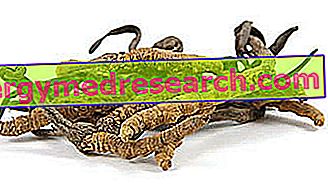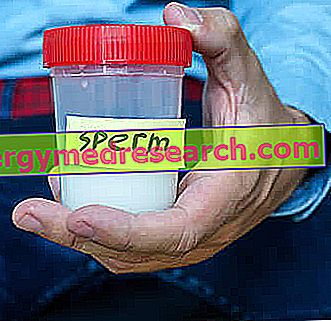Cordyceps sinensis is the botanical name of a mushroom, an ascomycete characteristic of Chinese medicine, which gives it tonic-invigorating properties, useful for increasing body energy, stimulating the immune system and improving physical endurance.
The first documents relating to the use of Cordyceps in Chinese folk medicine date back to 1760 BC; however, it was necessary to wait until September 1993 to see the mushroom rise to the honors of the Western chronicle. In those days, during the Chinese national swimming games in Beijing, three world records were broken in the 1500s, 3000s and 10, 000 meters. The physical structure of the swimmers and their amazing performances fueled suspicions about the probable use of anabolic substances, but the anti-doping tests denied this hypothesis.

The etymology of the botanical name Cordyceps sinensis can be traced back to the Latin word cord "catta", ceps "head" and sinensis "from China. In the United States, this fungus is instead known as" caterpillar fungus ", due to of a very particular biological cycle and certainly not inviting, the cordyceps, in fact, parasitically underground the larva of some moths (above all Hepialus armoricanus ) typical of the Tibetan highlands (3000-5000 meters of altitude, Qinghai plateau). of the larva, the cordyceps kills and mummifies the organism, until it comes out through its head. Not surprisingly, cordyceps is known in China as "DongChongXiaCao" and in Japan as "Tockukaso", which means "winter worm and plant of summer ". Since the larvae are infected by fungi in the summer and autumn months, then consumed by the mycelia and transformed into 'stiff worms' during the winter, the cordyceps are called 'winter worms' (DongChong), after which, duran In the spring and summer of the following year, the fungus stroma emerges from the ground, piercing the head of the larva; hence the term 'summer grass' (XiaCao). Due to the rarity of this fungus and its exceptional "curative" effects, several mycelia (vegetative apparatuses) have been isolated to produce the fungus through fermentative technologies; today, most of the cordyceps on the market has therefore been cultivated in a similar way to other mushrooms.
| Cordyceps, properties and potential applications |
Increase sexual activity, both in the male and in the female; reduce total cholesterol and increase HDL cholesterol; improve physical performance, especially in states of increased stress; cordyceps can therefore be useful for athletes and those who complain about reduced physical efficiency and poor ability to concentrate; hepatoprotective effect, with potential implications not only preventive, but also therapeutic in the presence of viral hepatitis, hepatic steatosis, liver fibrosis and liver cirrhosis; antihypertensive effect, with increased cardiovascular health; it can help in the presence of myocardial ischemia, atherosclerosis and related diseases; improve kidney function; rebalance blood sugar by lowering blood glucose levels; modulate the sleep-wake cycle in the presence of difficulty in falling asleep, thanks to a possible sedative effect in the central nervous system. |
In recent decades, various researches have attempted to characterize the active principles of Cordyceps sinensis, at the same time evaluating the scientific truthfulness of its presumed health properties and applications. Most of these studies have been conducted in China and seem to confirm - especially in vitro and on animal models - most of the properties ascribed to cordyceps by local folk medicine; it is however desirable to carry out clinical trials to confirm all these "miraculous" properties even in humans.
The chemical analysis of cordiceps shows - an excellent lipid content (57.84% of unsaturated fats, especially linoleic and oleic, 42.16% of saturated fats, headed by palmitic), proteins (29.1-33%), trace elements, vitamins and polysaccharides ( 3-8%). Although the active ingredients of cordyceps have not yet been clearly identified, at least two substances have been identified as important active constituents; we are talking about cordicepine, structurally very similar to D-mannitol, and of cordicepic acid, structurally similar to 3-deoxyadenosine. Equally important in determining the pharmacological activities of cordyceps appears to be its polysaccharide component, in which galactomannan abounds. Other bioactive compounds include nucleosides (Adenosine, Guanosine and Uridine) and phytosterols (ergosterol, an important precursor of vitamin D2). Finally, among metals, elements such as zinc, magnesium and manganese abound, which from a physiological point of view are very important for the development and maintenance of the gonads.
The published studies seem to confirm the properties of Cordyceps (especially in vitro and on animal models), in particular its immunomodulatory and antitumor, hypoglycemic, antihypertensive, promoter of hepatic, cardiac and renal, anti-aging, aphrodisiac function and health cholesterol-lowering, regulator of the sleep-wake cycle, antitussive, expectorant and anti-asthmatic.
Even the sportsman could benefit from the effects of Cordyceps, which has proved useful in promoting tissue oxygenation, through the relaxation of the bronchial, bronchiolar and vascular wall muscles; the increase in blood flow to the muscular and cardiac levels, the more effective use of oxygen by the body (increase in VO2max), and the positive action on the functionality of the immune system, make Cordyceps a suitable supplement especially for athletes engaged in resistance activities.
Cordyceps has proven to be a safe and well tolerated supplement, free of toxic effects or other risks; as for the vast majority of supplements, only isolated cases of mild gastric disturbances deriving from the ingestion of cordyceps-based products have been reported.



